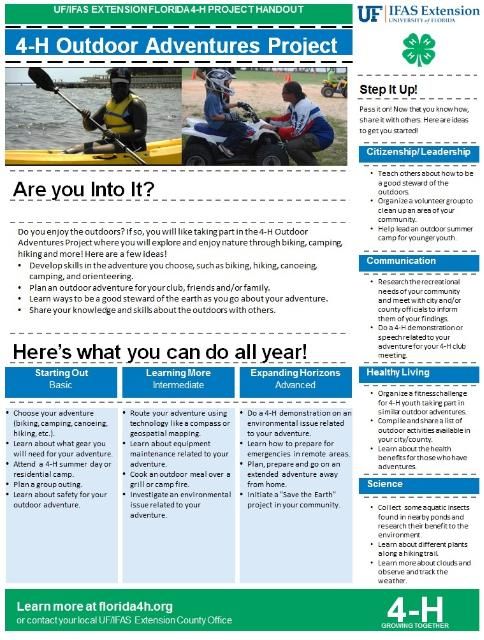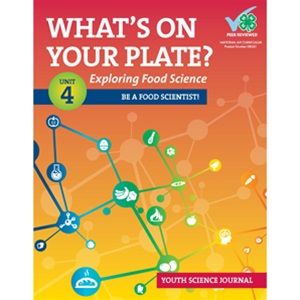What Is a 4-H Project?
A project is a planned series of learning experiences of six hours or more within a particular area of youth interest (Florida 4-H definition). The purpose of a 4-H project is to promote mastery of subject matter and to foster life skill development (i.e., communication skills, citizenship, leadership, good decision-making, and goal setting). Project learning is fundamental to the 4-H program and depends on you to:
-
Select and use quality educational materials.
-
Guide and validate youth learning as an adult role model through positive encouragement and support.
-
Use sound learn-by-using approaches, such as the experiential education model.
-
Engage youth in related events and activities—at the club, county, district, state, and national levels—that focus on sharing what they have learned with others. The opportunity for youth to share is an important component of a 4-H project and reinforces learning and fosters skills in communication. Some examples include presenting a speech on food safety or entering an exhibit at the county fair in photography or woodworking (Bender, Jordan, Thein, Hensley, & Henry, 2011).
Projects are based on goals youth have developed themselves with the help of a caring adult. Usually, members choose projects at the beginning of the 4-H year (i.e., in the fall, or any time after they have enrolled in 4-H). After the youth choose a project, they identify and write down the goals they wish to complete during the year.
Having youth write down SMART goals is a great way to get started. SMART goals are:
Specific
Measurable
Attainable
Realistic
Time-Bound
Good goals are meaningful to youth, are age-appropriate, and help to increase knowledge and experiences in a way that improves their overall abilities and resiliency. Here is an example of a great project goal:
In my Marine Science Project, I want to learn Florida marine animals and plants by the Marine Science Event in November. To do this, I need to attend all county meetings and field trips that will help me prepare for the event, and I need to study before the event.
Resources to Help Youth with Project Learning
A variety of resources are available to volunteers, youth, and families to assist youth in reaching their project goals.
Project Handouts
Project handouts are available for you to review and share with your 4-H members at http://florida4h.org/programs.
Downloadable project handouts for a variety of 4-H projects include the goal for each project; specific curriculum for youth, families, and volunteers to purchase; and ideas on how to develop communication, citizenship-leadership, healthy living, and science in their projects. Also included are events and other learning opportunities, as well as exhibit ideas and information on awards and recognition. Couple this information with all of the opportunities available in your county and you will see much is offered to help 4-H members to develop subject-matter skills and life skills.

Project Books
The 4-H project books are major resources for youth. 4-H member and leader guides, project books, and record books can all be obtained from your county 4-H office at nominal cost.
Many 4-H project materials have been developed by University of Florida's Institute of Food and Agricultural Sciences departments and from the National 4-H Council. If project materials are unavailable through your county office, you can access many directly at the following websites:
-
Extension Distribution Information System (EDIS) https://edis.ifas.ufl.edu/. Some materials through EDIS are PDFs that you can download and some are items for purchase.
-
UF/IFAS Extension Bookstore (http://ifasbooks.ifas.ufl.edu). These materials are for purchase only.
-
National 4-H Council (www.4-hmall.org). These project resources are for purchase only.
Another resource is called "my4-H" (www.4-h.org/my4h). You will need to sign up before logging in. At this site, you can search for a particular subject and find out where to locate the materials. Some are downloadable and some are for purchase.
Project books may be used for more than one year. The focus is on the goals that youth set. There are generally three levels of curriculum with a helper's guide. A helper's guide usually includes activities you can do with youth and or provides answers to problems youth are asked to solve in the youth guides.

Remember that Florida 4-H is a partnership between University of Florida, your local county, and the USDA. This partnership was brought forth to bring sound learning and research from our land-grant universities to Florida citizens. This is why using UF/IFAS (and other land-grant university materials) is important to our 4-H program.
Youth at the beginning of their 4-H Year sign up for one or more projects. Here is a list of many of the projects they can choose from:
Animals
Beef
Cats
Dairy Cattle
Goats
Dog
Horse
Pets
Poultry
Rabbits
Sheep
Swine
Veterinary Science
Nature and the Outdoors
Earth Science
Environment
Environmental Stewardship
Fishing
Forestry
Insects
Marine and Aquatic Science
Outdoor Adventures
Soil and Water
Shooting Sports
Wildlife
Plants and Gardening
Gardening
Family and Consumer Sciences
Child Care
Clothing and Sewing
Money Management
Healthy Living
ATV Safety
Food and Nutrition
Personal Well-Being
Science and Technology
Aerospace
Bicycles
Computers
Electricity
Energy
Geospatial
Robotics
Small Engines
Woodworking
Communications and the Arts
Communications—Public Speaking
Expressive Arts
Visual Arts
Citizenship/Leadership
Careers—Workforce Preparation
Citizenship
Community Service
Leadership
Florida 4-H also offers a variety of curriculum materials designed specifically to be used in schools and afterschool environments. Please refer to http://florida4h.org under the priority areas of Science, Healthy Living, and Citizenship/Leadership to learn more about these resources. Also, check out the list of curriculum in our Curriculum Clearninghouse at http://florida4h.org/programs_/.
4-H Project Reporting Forms
A well-rounded 4-H club member is expected to complete annual 4-H project record forms. Record keeping is a life skill that helps youth learn how to reach goals, identify what they have learned throughout the year, and keep track of project expenses. This workforce skill also helps 4-H members keep good records that can be used to apply for awards and scholarships and to complete job and college applications. Completing report forms is also a requirement for some county, state, and national awards.
These reporting forms are found at http://florida4h.org/youth_/awards-and-recognition/:
-
Cloverbud Participation Summary (ages 5–7)
-
Junior Project Report (ages 8–10)
-
Intermediate Project Report (ages 11–13)
-
Senior Project Report (ages 14–18)
-
Financial Summary
4-H Cloverbud Materials
Because of their age, 4-H Cloverbuds (ages 5–7) generally do not choose specific projects. Leaders generally choose learning opportunities for this age group with the focus on cooperative learning instead of competition. It is important that Cloverbuds learn in a group setting guided by an adult leader. 4-H leaders should choose age-appropriate, Cloverbud-specific materials. If you would like to introduce Cloverbuds to discover 4-H and explore different 4-H projects, you may want to encourage Discovering 4-H and Exploring the Treasures of 4-H curriculum, available from National 4-H Council or your county office. In addition, The Ohio Cloverbud Program Series I and II are good materials for Cloverbud volunteers to use with groups of children. Other materials and resources to order or download are available on the Curriculum Clearinghouse (http://florida4h.org/programs_/) under the Cloverbud category.
References
Bender, G., Jordan, J., Thein, A., Hensley, S., & Henry, K. (2011). Florida 4-H Project Leader Guide. Gainesville: UF/IFAS. https://edis.ifas.ufl.edu/pdffiles/4H/4H31600.pdf.